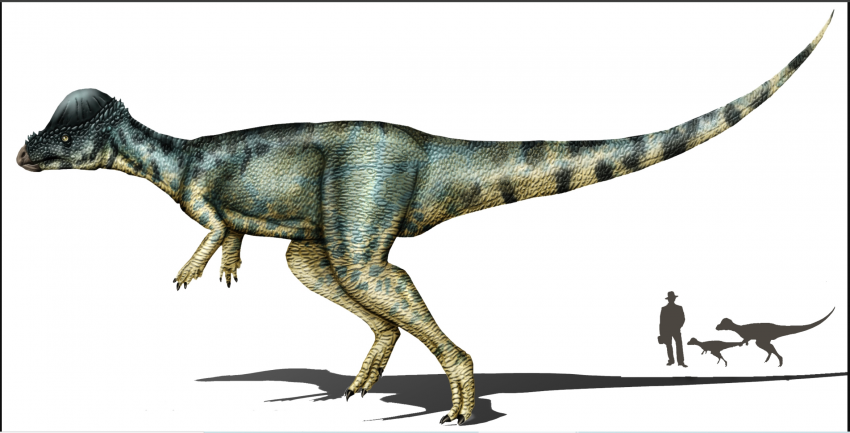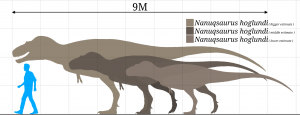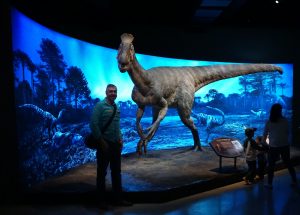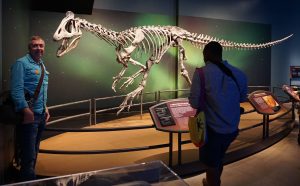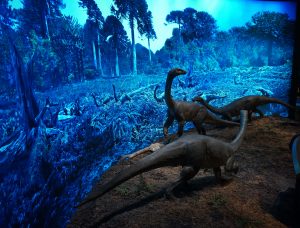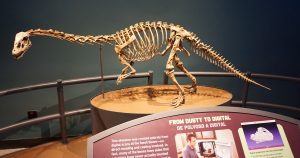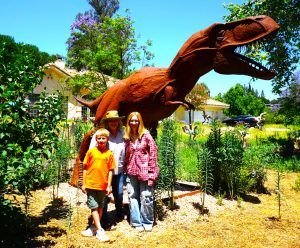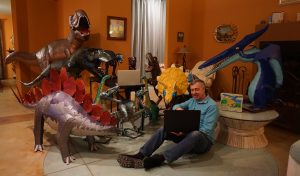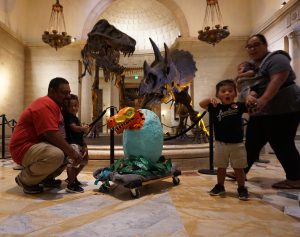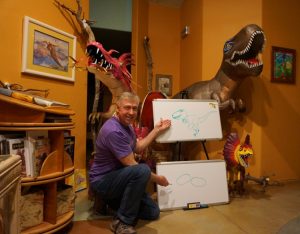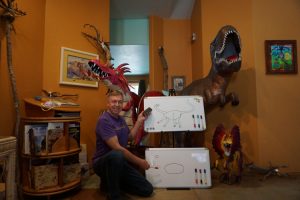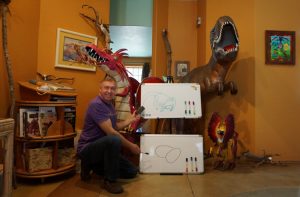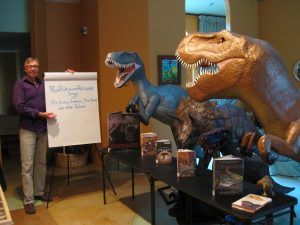Alaskacephale gangloffi with size comparison to human and larger Pachycephalosaurus by Karkenish own work.
Dinosaurs Ruled the Earth for over 150 million Years! Fossils of their bones, eggs and tracks have been found around the globe. In Alaska which was much further North than it is today, Dinosaurs thrived. Although temperatures were warmer similar to the US Pacific Northwest, Dinosaurs still had to deal with the 3-4 months of darkness. Hadrosaurs were larger. Even Troodon was much larger than those that lived in other parts of North America. But oddly a Tyrannosaur that was much smaller than T-Rex roamed this cold region. Alaska’s Denali National Park has an Incredible Track Field that includes impressions of Hadrosaurs scales, as well as various sizes indicating they were made by Babies, Juveniles, Adolescents and Adults. This Track Field suggests that these Dinosaurs survived in the area all year round vs. migrating South as many animals do today. The distance for land migration would have been much farther than any land animal migrates today. It’s been theorized that Dinosaurs may have hibernated as modern reptiles and mammals do today. Of the many Dinosaurs found in Alaska Ugrunaaluk (Hadrosaur), Parksosaurus, Pachyrhinosaurus pertorum, Alaskacephale gangloffi (Pachycephalosaurid), and Nanuqsaurus (meaning Polar Bear Lizard a Tyrannosaur) have characteristics allowing them to have their own species classifications.
As the Continents moved further apart many Dinosaurs developed unique traits. In Australia – Muttaburrasaurus, Australoventor, Minmi, Galleonosaurus, Leaellynasaurus, Rhoetosaurus and Savannasaurus. Even today Australia has a variety of animals not found in any other parts of the World. Antarctica, which was a Tropical Forest during the time of the Dinosaurs, had its special families that had adapted to the months of darkness, as well. Cryolophosaurus, discovered in 1990, derived from Greek for cold or frozen crested lizard. In 2019 the Natural History Museum in Los Angeles presented an Exhibit of Antarctica Dinosaurs. A fleshed-out creation of Cryolophosaurus with a backdrop of his Antarctic environment of the time. A group young Glacialisaurs play in their native recreated meadow & forest. These Sauropodomorphs are the ancestors of the great Titanosaurs that thundered across the Globe many years later. At about 25 feet long for an adult, they seem tiny compared to the Sauropods that will follow after them.
My sister Kay brought her neighbor Sue along with Addison & Hunter (Sue’s grandkids) to visit the Park. They were introduced to all the Prehistoric Pals outside including Malcolm the Mailosaurus. Malcolm was not in camouflage mode. So, they were able to see him in full color. I advised them that Mailosaurus’ ordinarily look like a typical mailbox when camouflaged. Therefore, they may have some in their own neighborhoods. The outdoor tour ended with a photo opportunity under Sasha. Kay is camera shy so she avoided the camera like someone running from Raptors. We ventured inside to meet 9 more of the Prehistoric Pals. They Checked Out Real Dinosaur Fossil Teeth and some Crafty Paper Dragons in Xiuhcoatl’s Room. I shared a peek at my Dinosaur Art and the beginnings of a Dinosaur Comic I’m creating. A Good Time for All!
Stay Tuned for More Dinosaur Fun Facts, Fiction & Crafts!
Consider a Membership with the Museum. In addition to Supporting Their Valuable Work there are Benefits to You. Special Preview Events for Members Only as well as Virtual Access Exclusive for Members. Below are 3 of my favorites Museums. For more information and access to general public eLearning check out the links below.
The Natural History Museum of Los Angeles County www.nhm.org under Research & Collections / Digitized Collections will allow you to browse their Collections. Check out the latest Activities on their site. Mark Your Calendar for the 9th Annual Dino Fest – Saturday September 21st!
The American Natural History Museum www.amnh.org You will find eLearning for Families, Students & Educators. Explore the Museum Virtually. Check Out SciCafe: Video Talks and Meet the Icons: Stories behind the Exhibits! There are Video Series covering Behind the Scenes at the Museum with Space & Dinosaur Explainers.
Chicago’s Field Museum www.fieldmuseum.org You can talk to “Maximo the Titanosaur” online, Yes Really! Visit Sue the largest T-Rex discovered! Check Out “Brain Scoop” and the Learning Resources – many are also in Spanish.
Check Out Your Libraries eBooks. My local Library has over 900 eBooks on Dinosaurs! Here are four books for Drawing Dinosaurs that you might find at your Library. Ask your Librarian about others.
1-2-3 Draw Dinosaurs and other Prehistoric Animals A step by step guide by Freddie Levin (2001)
Draw 50 Dinosaurs and other Prehistoric Animals by Lee J. Ames (1977)
Draw it Dinosaurs by Patricia Walsh (2006)
I Can Draw Dinosaurs by Terry Longhurst (2003)
Stay Safe & Well
“Encouraging the Appreciation of Art and Education through the Inspiration of Dinosaurs”
Paul & Prehistoric Pals
Your feedback is appreciated, comment below or email:
Thank you!
